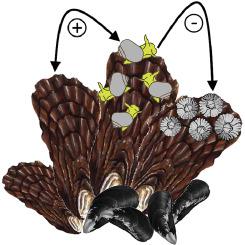Estuarine, Coastal and Shelf Science ( IF 2.8 ) Pub Date : 2020-08-03 , DOI: 10.1016/j.ecss.2020.106936 Annika Cornelius , Christian Buschbaum

|
Introduced bioengineering organisms may fundamentally change native coastal ecosystems by modifying existing benthic habitat structures and thereby habitat-specific species interactions. The introduction of the Pacific oyster Magallana gigas into the sedimentary coastal area of the south-eastern North Sea and its preferred settlement on native blue mussel shells caused a large-scale shift from monospecific Mytilus edulis beds to current mixed reefs of mussels and oysters. To investigate whether the newly developed biotic habitat affects the occurrence of associated native key organisms and their ecological functions, we studied the long-term density trajectory of the gastropod Littorina littorea and its grazing activity on barnacles attached to Pacific oyster reefs in the northern Wadden Sea. We found no significant correlation between oyster and snail densities on blue mussel beds in the last two decades, which spans a time-period from the beginning of Pacific oyster establishment to today's oyster dominance. A manipulative field experiment revealed that snail density significantly affects the recruitment success of barnacles Semibalanus balanoides on oyster shells with the highest number of barnacle recruits at snail exclusion. Thus, density and grazing activity of the snail L. littorea may control barnacle population dynamics on epibenthic bivalve beds in the Wadden Sea. This interspecific interaction was already known for blue mussel beds before the oyster invasion and, therefore, we conclude that despite the strong modifications that non-native ecosystem engineers cause in native biotic habitats, the ecological functions of associated key species can remain unchanged.
中文翻译:

海洋生态系统工程师的介绍改变了原生生物的栖息地,但不一定改变了物种之间的相互作用
引入的生物工程生物可以通过修改现有的底栖生境结构,从而从根本上改变原生沿海生态系统,从而改变特定生境的物种相互作用。将太平洋牡蛎Magallana gigas引入北海东南部的沿海沿海地区,以及其优先选择的原生蓝贻贝定居点,导致了大规模的转变,从单一的贻贝(Mytilus edulis)河床转变为目前的贻贝和牡蛎混合礁。为了研究新近开发的生物栖息地是否会影响相关的本地关键生物的发生及其生态功能,我们研究了腹足纲小鸟Littorina littorea的长期密度轨迹。及其在瓦登海北部太平洋牡蛎礁上的藤壶上的放牧活动。在过去的二十年中,我们发现蓝色贻贝床上的牡蛎和蜗牛密度之间没有显着的相关性,这跨越了从建立太平洋牡蛎开始到今天的牡蛎主导地位的一段时间。一项现场操作实验表明,蜗牛密度显着影响藤壶Semibalanus balanoides在牡蛎壳上的募集成功率,而在蜗牛排斥时藤壶数量最多。因此,蜗牛L.littorea的密度和放牧活性可能控制瓦登海表皮双壳动物河床上的藤壶种群动态。这种种间的相互作用在牡蛎入侵之前就已经知道蓝贻贝床,因此,我们得出的结论是,尽管非本地生态系统工程师在原生生物栖息地中进行了重大修改,但相关关键物种的生态功能仍可以保持不变。



























 京公网安备 11010802027423号
京公网安备 11010802027423号